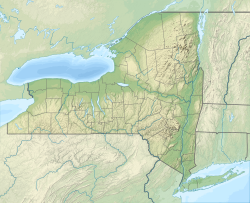| Cazenovia Creek | |
|---|---|
 Cazenovia Creek flowing through Cazenovia Park in South Buffalo | |
| Location | |
| Country | United States |
| State | New York |
| County | Erie |
| Physical characteristics | |
| Source | |
| • location | Aurora |
| • coordinates | 42°45′38″N78°38′42″W / 42.76056°N 78.64500°W [1] |
| Mouth | Buffalo River |
• location | South Buffalo |
• coordinates | 42°51′40″N78°49′36″W / 42.86111°N 78.82667°W [1] |
| Basin features | |
| Tributaries | |
| • left | West Branch Cazenovia Creek |
| • right | East Branch Cazenovia Creek |
Cazenovia Creek is a creek in Western New York, United States. It is a tributary of the Buffalo River, which empties into Lake Erie. Cazenovia Creek and its watershed are entirely within Erie County. [1]


